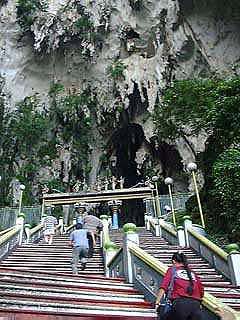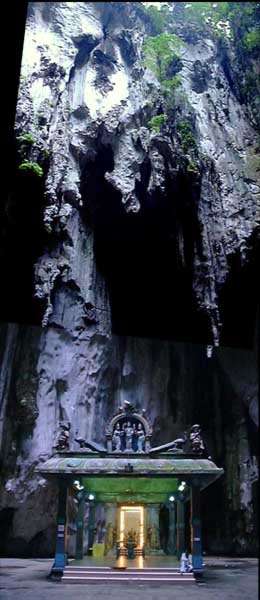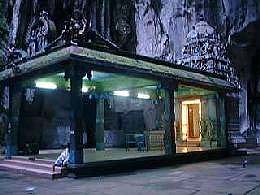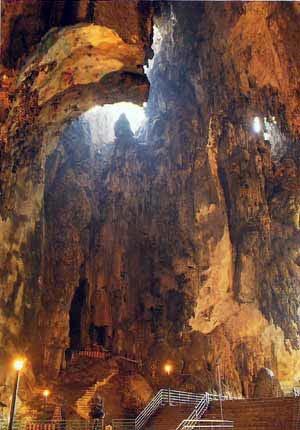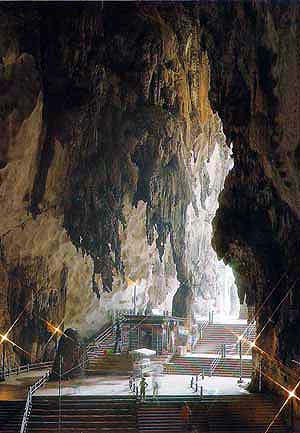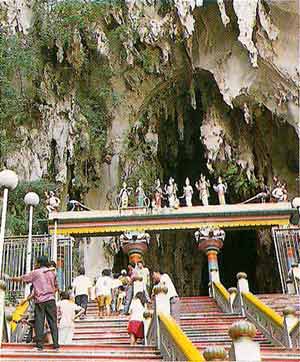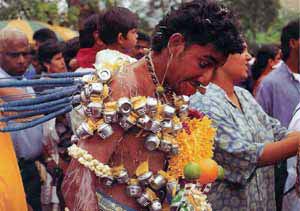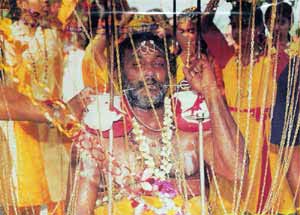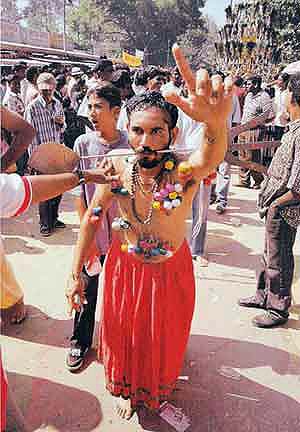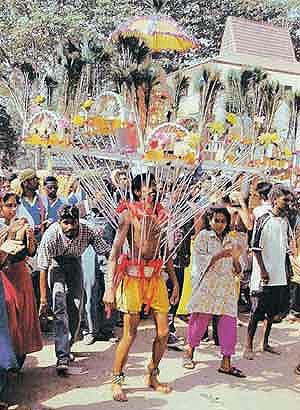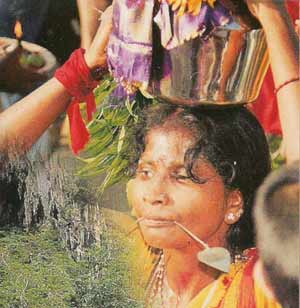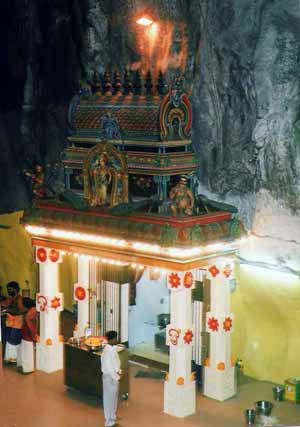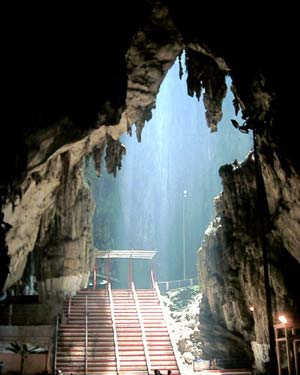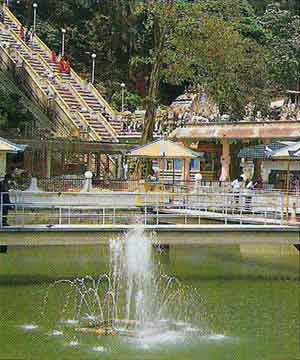
|
||||||||||||||||
|
| ||||||||||||||||
Malaysian Hindu Pilgrimage: Kavadi Worship at Batu CavesBy Carl Vadivella BelleThis paper will explore aspects of kavadi worship as it is practiced within the framework of the Hindu festival of Thaipusam at Batu Caves, in Malaysia. Essentially, I will argue that the kavadi ritual falls within the received paradigms of bhakti (devotional) worship of the deity, Murugan, and that its performance represents the transplantation and adaptation of an accepted pilgrimage tradition involving asceticism and complex symbology. In the opening section I have traced the origins and development of Malaysian Hinduism, and highlighted the centrality of Murugan and Thaipusam to the modern Hindu identity. I have then described the mythology which accompanies Murugan's acquisition of the vel (spear or lance), and its centrality to Thaipusam. A brief overview of the festival follows, thus sketching the cultural and religious setting in which kavadi worship occurs. In the following section I have outlined the mythology surrounding the asura (demon) Itampan, and the concomitant justification of the kavadi ritual. I have also provided a basic outline of the pan-Hindu pilgrimage ritual, the tirtha -yatra (journey to the crossing place). In the final section I have described the individual devotee's detachment, asceticism and deployment of the Murugan cultus in undertaking the kavadi pilgrimage. I conclude by suggesting that kavadi worship provides layers of meaning to Malaysian Hindus, and that its adaptation at Batu Caves signals a variety of allegiances, including a broader identification with a generic pan-Hindu heritage. I should acknowledge my strong personal commitment to kavadi worship. My interest in Thaipusam has lead to a series of pilgrimages to Batu Caves, Penang and Palani as a participant. My views, therefore, are shaped by two major influences - firstly my role as an "insider", albeit that of a "Western" pilgrim, and secondly, the spirit of scholarly inquiry. Many of the observations contained in this paper are the result of extensive fieldwork. The topics contained in this paper are immensely complex, and it is impossible to reduce these subjects to manageable proportions without some simplifications and generalizations. These issues are the subject of postgraduate study and will be explore in greater detail in that work. I should note that I have used the accepted Malaysian spelling of the terms "Thaipusam", "kavadi", "Murugan" and "Agamic". I have italicized specialist Tamil and Sanskrit terminology. HINDUISM IN MALAYSIA: AN OVERVIEWHinduism has been re-created (Raghavan) as a significant minority religion in Malaysia as a result of the waves of Indian migration which began in the wake of the British acquisition of the Straits Settlements from the late 18th century, and intensified with the extension of British rule over the remainder of the Malay Peninsula. Large scale Indian migration continued up until the eve of the Pacific War (Sandhu). The bulk of Indian migration consisted of indentured and later assisted labour which was recruited to serve as an unskilled workforce within the expanding plantation economy and Malayan public utilities. The labour force was drawn almost exclusively from the Madras Presidency, and consisted mainly of Tamils, but included small minorities of Telegus and Malayalees (Sandhu). These groups were responsible for transplanting Dravidian village Hinduism to Malaysia. However, there were other migratory streams each of which made a distinct and enduring contribution to the overall fabric of Malaysian Hinduism. These strands included:
In 1990 Indians comprised 8% of Malaysia's population (Far Eastern Economic Review, 7 June 1990). 1970 figures indicated that 80% of Malaysian Indians belonged to the working class. Approximately 80% were Indian Tamils, 8.1% other Dravidians, 7.7% North Indians and 2.7% Ceylon Tamils. Approximately 80% of Indians identified themselves as Hindus (Rajoo: 1983: p. 101). Hinduism in Malaysia has developed in the absence of those traditional sources of authority - the religious centres of learning or monastic orders (math) which have provided a system of hermeneutics and scriptural exegesis, and an influential Brahman or orthodox caste - which have shaped Hindu structures, belief systems, mythology and patterns of worship in India. Malaysian Hinduism has historically been dominated by Dravidian folk religions, the so-called "little" traditions or village Hinduism. These have been characterized by the centrality of Mother (Amman) worship, the worship of "little" deities, the construction of non-Agamic temples served by lower caste pucari-s (priests), spirit mediumship (sometimes employing rituals based on "left-handed" or "debased" Tantrism), folk beliefs and animal sacrifice. These folkish practices and beliefs continue to pervade Malaysian Hinduism at all levels of society, and are often found among educated Hindus (including those who profess an orthodox Saivite/Agamic background). Superficially Malaysian Hinduism remains a loosely integrated system, free of a predominant authoritative tradition, and containing a bewildering diversity of religious forms. However, this outwardly emphatic pluralism masks various unifying tendencies, whose genesis can be traced to postwar Hindu reform movements (Arasaratnam: 1970: pp 162-176). These groups, which included the influential Malayan Hindu Sangam, reflected a renewed interest in the Indian Hindu heritage, and were strongly steeped in Dravidian ideologies. They aimed at promoting an over-arching model of Agamic ("great tradition") Hinduism, a reanimation of Tamil arts and literature, and the discouragement of local beliefs and practices built around caste, class, sects, and regional loyalties. Centripetal impulses include the Tamilization of Malaysian Hinduism, syncretization of village/ Agamic Hinduism as well as Saivite/Vasihnavite motifs, a process of Sanskritization/Agamicization, and the popularization of major Sanskritic festivals (Rajoo: 1984: p.105). These unificatory impulses have been fuelled by a perceived need to reinterpret traditional forms of Hinduism to create a Hindu identity more responsive to the imperatives of multi-ethnic Malaysia. The paradigmatic model of reform has been Saiva Siddhanta, an orthodox Agamic philosophical system of Saivism, practiced and propagated by upper class and educated Hindus (Arasaratnam: 1970: p. 167). The promotion of Saiva Siddhanta has been assisted by the gradual blurring of caste boundaries (Rajoo: 1983: p.102) which has softened traditional hierarchical divisions of religious practice and belief. Reformulation of Hinduism has been impelled by issues of class and status. Agamicization is viewed by working and lower class Hindus as not only a method of seeking a common cultural alliance with upper class Hindus, an affirmation of group cohesion, but also a means of attaining identification by the dominant Malaysian ethnic groups as equal partners with higher status Indians within an ancient, rich and defining philosophical and religious tradition (Rajoo: 1984: p.168).
The central unifying factor in the tortuous recasting of Malaysian Hinduism is the deity Murugan, who reaches most sectors of Malaysian Hindu society. Murugan is a pan-Tamil Agamic identity, readily accepted within the framework of Saiva Siddhanta. Moreover, through a protracted process of syncretism, Murugan has absorbed a broad range of motifs, attributes and belief structures which render him both acceptable and accessible to all layers of Tamil society (Clothey: p.71). Within the anti-Brahman milieu that constitutes a leitmotif of modern Tamil politics in Malaysia (Amplavanar), Murugan can be portrayed as a Dravidian god par excellence, freed from the imagined despotism of northern "Aryan" traditions. Given this context, it is not surprising that Thaipusam, a major festival dedicated to Murugan, has emerged as the largest and most widely observed Malaysian Hindu festival. Its growing popularity as expressed in the ever increasing crowds (over one million devotees journeyed to Batu Caves for the 2001 festival) and the swelling ranks of kavadi (ritualized burden) bearers, underscores its perceived relevance to Malaysian Hindus. While Thaipusam in Malaysia is consciously modelled upon the mythology, traditions and rituals celebrated at Palani, Tamil Nadu, the processes of relocation and adaptation have endowed it with a character which is uniquely Malaysian. MYTHOLOGY: MURUGAN'S ROLEAmong Malaysian Hindus, Thaipusam is usually is described as a festival commemorating Murugan's acquisition of the Sakti Vel (electric spear or Vetrivel) bestowed upon him by Parvati, consort of Siva, at the commencement of Murugan's campaign to defeat Surapadman, head of the Asura-s (demons or lower astral beings). The mythology which describes the creation of Murugan and the cosmic role accorded to him begins with Siva's withdrawal from the world to concentrate upon austerities and meditation. However, prior to his retreat, he granted extensive boons to the asura-s, Surapadman, and his two brothers, all of whom had been performing powerful tapa-s (austerities) to him. In Siva's absence, the asura-s, headed by Surapadman, quickly conquered the world. They created terror among the celestials, and subjected them to countless indignities. Their rule was characterized by torture, persecution, and a total disregard for the laws of dharma. The celestials petitioned Siva to intervene on their behalf. In response to their entreaties Siva sprouted five additional heads and from each of his (now) six heads produced a divine spark. The sparks ultimately matured into the forms of six baby boys, who were each assigned to the individual care of one of the six Pleiades maidens (Krttika-s). Later, upon seeing their rightful mother, Parvati, the six babies rushed to her and were embraced, so that they fused into one being with six heads and twelve arms, the form of Murugan known as Shanmugam or Aramugam. Throughout his brief infancy, Shanmugam displayed extraordinary talents, sometimes engaging in childish behaviour which reflected lack of awareness of his own strength and intrinsic qualities. Characteristic actions included upending mountains, damming the waters of the Ganges, and altering the orbits of the planets (Handelman: p.140). His most celebrated childhood act was the imprisonment of Brahma. Brahma had refused to acknowledge Murugan's divine status as the son of Siva. Murugan, annoyed, had asked Brahma a series of questions regarding the inner meaning of the profound mystical symbol, the Pravana Aum. When Brahma could not answer, Murugan had him beaten and thrown into jail. Siva, alerted to this development, approached Shanmugam and playfully requested him to explain the significance of this sacred symbol. Dutifully Murugan instructed his father in the mysteries of the Pravana Aum. Following his boyhood, Murugan was presented with the Vel by Parvati. Accompanied by his generals and an army of Deva-s (celestials), Murugan left Mt. Kailas, Siva's abode in the north of India, and headed southwards to combat the asura-s. The great battle raged for six days. The final phase of the conflict resulted in the direct confrontation of Murugan and Surapadman, the demon king. Realizing the immense power of Murugan, and that defeat in a straight fight was inevitable, Surapadman employed all the illusory powers he had been taught, assuming the forms of a number of birds and animals. However, Murugan was beyond any delusion, and quickly flushed Surapadman from each of his disguises. Toward the conclusion of the battle, Murugan appeared before Surapadman in "...his own true and eternal form: the cosmos and all of its constituent elements organized hierarchically from the highest (at the head) and encompassed in the figuration of a male with one head and two arms, the transcendent male principle that is identified with Purusa, Cosmic Man" (Handelman: p.143). Overwhelmed by Murugan's effulgent brilliance, Surapadman was temporarily consumed with Divine Love, but when Murugan reverted to the form of Shanmugam (i.e. with six faces, twelve arms and twelve eyes), Surapadman assumed the form of a massive cannabalistic monster with a thousand arms and a thousand legs, and launched a frenzied attack. Murugan split Surapadman in two with his Vel, and Surapadman then took shape as a peacock and rooster both of which attacked Murugan. However, Murugan tamed them with a loving glance. To commemorate the defeat of the asura-s, Murugan ordered that the peacock and rooster should respectively become his vahana (mount), and the emblem of his standard. Zvelibil (1991) has shown that all Tamil mythology is multivalent, and thus interpretable on several planes, namely as a story, metaphorically, and as a cosmological expression of metaphysical principles and divine truths. At the cosmological level, this myth represents nothing less than the process of phenomenological entropy and dissolution, and its subsequent reconstitution and renewal. The Divine has two essential states. Being, the passive, is known as Siva, and becoming, the dynamic, is known as Sakti. These are popularly envisaged as masculine and feminine respectively. Without the feminine aspect, Siva is remote and unknowable, and without the masculine aspect Sakti has no existence. The constantly shifting relationship between Siva/Sakti (i.e. Absolute and Generative power) pervades all Saiva Siddhanta thought, and is held to operate on every level of cosmic awareness. Thus the conferral by Sakti (Parvati) of the Vel, the instrument by which cosmic harmony is re-established, upon (the Siva created) Murugan, represents a manifest fusion of the Divine's absolute and generative powers. At the metaphorical level the mythology has profound implications for the individual devotee, not least the resolution between the deity who is at once transcendent, the remote regulator of divine (cosmic) dharma, and imminent, closely involved with the affairs of the devotee. The battlefield is internalized, and the Vel becomes a symbol of the means to attain spiritual liberation. The "birth" of Murugan is recognition of the yogic grace extended by Siva. Murugan is created by Siva to destroy the bondages of ignorance imposed by the individual ego, but is furnished with the means to do this (the Sakti Vel) by Parvati. Murugan is perceived as the principle of Siva-Sakti in action within the substance of the mind. The stages along the route to moksha (liberation) are clearly delineated within the mythology. Shanmugam, the initial, rather unwieldy, combination of manifest and unmanifest elements, represents the first initial fumbling and undirected steps of the aspirant's quest. As we have seen, Shanmugam is unstable, wilful and often instinctive. The instruction of Siva in the intrinsic meaning of the Pravana Aum, the primordial unit of creation, indicates growing awareness of his divine powers, nature and identity. This initial phase concludes with the bestowal of the Sakti-Vel, the spear of knowledge. Murugan sets off on his campaign from Mt. Kailasa, divine home of Siva in the north of India, and passes through six sacred cities before his final defeat of Surapadman at Tiruchendur in the extreme south. Esoterically, north is held to symbolize Siva (Being/Absolute), while the South symbolizes Sakti (Becoming /Generative), while those locations in between are various combinations. The human body is seen as the replica of the universe, the north being at the crown of the head, the far south the souls of the feet, the centre at the base of the coccygeal plexus (the base of the spine). The region from head to foot is divided into fourteen sections, representing the fourteen worlds. Each of these sections is conceived of metaphorically as a cakra, that is, a centre of psychic energy, regulating a dominant aspect of human unfoldment (Zvelebil: 1973). Human spirituality emerges at the Muladhara Cakra, located at the base of the spine, and ascends through six psychic centres, the higher cakra-s. Access to and stablization within the Muladhara Cakra, and thus the prospect of further spiritual ascension, is controlled by Murugan's younger brother, the elephant deity, Ganesha. Murugan's descent from the north in response to the entreaties of his devotee and the granting of successive access to each of the higher cakra-s (sacred cities), thus overcoming the counterpull of the seven worlds below the coccygeal plexus, represents the progressive triumph of yogic knowledge over illusion. Murugan's stablization, his progression to mature spiritual power proceeds as the divine campaign against the asura-s unfolds. The final battle between Surapadman (ego) and Murugan (universal wisdom) demonstrates the ultimate stages of this transformation. Throughout this conflict Surapadman appears in many forms each of which demonstrates the delusions bestowed upon awareness by the sense of ego. Each of these camouflages is uncovered by Universal Wisdom. As the ego is isolated and its power gradually blunted, the aspirant gains a brief and fleeting vision of Murugan as Purusa, the actualization of Cosmic Truth, representing the enlightenment he/she has been seeking. For the true nature of Murugan is not his early development as Shanmugam, a capricious multiform of six heads and twelve arms, but Purusa, the transcendent principle who embodies the entire cosmos. In contrast, the true nature of Surapadman is a multiform of a thousand heads, which depends upon ignorance and the force of illusion for its continue existence. (Handelman: p.149). Thus the ego makes one final attempt to reimpose its dominance, and mutates into a frenzied cannabalistic monster. The destruction of Surapadman signals the irrevocable shattering of the ego through the power of Divine Grace; the irresistible Sakti force of the Absolute. The concept of a universe in dynamic tension, the incessant shifting relationship between the Siva/Sakti, ties all elements and polarities within a unifying framework, indissolubly fuses both macro and micro cosmology (i.e. individual/universal) and creates a divine symmetry. This is central to both Saiva Siddhanta theology and popular Tamil belief, and finds full expression in the festival of Thaipusam. THAIPUSAM IN MALAYSIA: HISTORY AND BASIC STRUCTUREThaipusam was first celebrated at Batu Caves in 1888. According to popular tradition, this was initiated by Mr Kayaroganam Pillai, founder of the Śrī Maha Mariamman Kovil (temple) in central Kuala Lumpur, who dreamed that the Sakti (goddess) directed that he build a shrine for her son Murugan at the top of the hill at Batu Caves. (Neelvani) Within several years Thaipusam became a significant festival at Batu Caves. The connection with the Sri Maha Mariamman Kovil was formalized, and the temple assumed responsibility both for the management of Batu Caves and for the organization of Thaipusam. From the very outset worship at Batu Caves was modelled on that of Palani, one of the great pilgrimage centres in South India, and dedicated to the worship of Murugan (Clothey, p. 117). As a site Batu Caves combined a number of motifs closely associated with the Murugan cultus, including caves, mountain top retreats and wilderness (as Batu Caves was at the time of the initial development; the site was 12.8 kilometres from Kuala Lumpur and surrounded by dense jungle. Over the years the complex has been enveloped by encroaching suburbia.) Since World War II Batu Caves has been extensively redeveloped. The Caves have become the preeminent pilgrimage site for Malaysian Hindus, and the temple management has aimed at creating a cultural and educational centre which provides information on all aspects of Murugan worship. Thaipusam in Malaysia is staged over a three day period. The Festival commences with the early morning placement of the Śrī Maha Mariamman Kovil's murthi (image of deity) of Murugan in the temple's silver chariot. Now symbolically armed with the Vel, Murugan departs upon the journey to his home in the mountains at Batu Caves. Despite the pre-dawn start. A large crowd, representing all segments of Malaysian Hindu society, turns out to accompany the chariot on its processional routes. (Police estimates range to 150,000 but unofficial sources place the figure much higher.) Upon arrival at Batu Caves, the murthi of Murugan is transferred to a prepared platform in a downstairs shrine, and a special installation puja (worship) is performed. Later the golden vel from the chariot is presented to the chief pandaram (non Brahman temple priest) from the Sri Subramanya Kovil, who carried the vel upstairs to the hill shrine within the main cave. The Vel's transforming power has now been symbolically shifted to the Cave, where Murugan awaits to receive those devotees who have pilgrimaged to his shrine. The bulk of the second day is devoted to formal acts of worship and service. The attention of the vast crowd is largely focused on the vibrant spectacle on the thousands of devotees who fulfill vows by taking kavadi. However, other Hindus meet spiritual obligations in less obvious ways, including serving in panthal-s (service stalls), supplying meals and drinks to members of the public, or providing first aid and other essential services. The third day of Thaipusam is devoted to the return journey of Murugan to the Śrī Maha Mariamman Kovil. Between 8 and 9 a.m. the golden Vel is removed from the shrine and restored to the murthi downstairs. Murugan is then reinstalled in the silver chariot, and leaves Batu Caves. Because of traffic restrictions the processions halts for most of the day in the suburb of Sentul, and does not resume its journey until 6.30 p.m. A large and intense crowd accompanies the chariot to the Śrī Maha Mariamman Kovil. THE KAVADI RITUAL: MYTHOLOGYThe kavadi ritual, a pre-eminent feature of Thaipisam in Malaysia, is legitimated and given shape by the mythology surrounding the asura-turned devotee, Itampan. This is outlined in the following paragraphs. Agastya, a rishi (sage) journeyed to Mt. Kailasa, to worship Siva. Siva asked that Agastya transport two hills, Sivagiri and Saktigiri, to South India, as seats of worship. Agastya commissioned the demon Itampan, an asura who had served in the army of Surapadman, to undertake this task. Itampan collected the hills, and tied them to a simple shoulder pole by means of sacred serpents which were used in the place of ropes. This was the prototypical kavadi. Near the forest at a site now known as Palani, Itampan, weary, set the hills down while he rested. When he attempted to resume his journey, he found that the hills were stuck to the ground. Upon ascending the slopes he encountered a youth clad only in a loin cloth, holding a staff, and "...shining like a thousand suns." (Zvelebil: 1991). This youth claimed the hills as his own. The myth provides a paradigmatic model for a specific form of ritual worship. Zvelebil remarks (1991: p.32) that "...one of the functions of this myth is to explain and authorize the custom of kavati so widespread among Murugan worshippers in South India, Ceylon and Malaysia". And Clothey states (p.120) "All devotees who bring the kavati or submit to the god on the hilltop are thought to be reenacting the example of that primordial devotee, whose malevolence and simple mindedness were taken from him in that act of worship." As with Itampan, kavadi worshippers are transformed and relieved of the burden of ignorance through assuming the burden of the divine. While to most Malaysian devotees the word "kavadi" connotes "burden", there is no single agreed burden which must be borne at Thaipusam. However, there are several unifying motifs. Firstly, in bearing a kavadi, the devotee in emulating Itampan, is submitting to the will of a specified deity. Secondly the kavadi is viewed as a miniature shrine containing the deity himself, so that the devotee may view him/herself in the manner of a vahana. Thirdly, devotees will bear a gift of milk to be presented to Murugan in his shrine within the Caves. While kavadis range from the simple to the complex, most involve some form of bodily mortification. Many kavadi bearers also take miniature vel-s, one of which is pushed through the tongue, the other through the cheeks. The most simple kavadi is undoubtedly the pal (milk) kavadi. This consists of a small wooden pole surmounted by an arch. Devotional pictures of murthi-s may be fixed under the arch. The kavadi many be decorated with peacock feathers, margosa leaves, flowers and other materials. This style of kavadi is recommended as the "approved model" by senior Malaysian Hindus. This was also the type of kavadi born by the Brahman group with whom I undertook a pada yatra (foot pilgrimage) to Palani in 1998. Other kavadis may require the insertion of hooks or needles into the torso, or the bearing of large spears which are pushed through the cheeks and may measure up to three metres in length. Not all kavadis are borne for Murugan. Indeed, a wide range of deities are represented at Thaipusam. Kavadis may be carried in honour of other Saivite deities (Siva, Ganesha, Parvati), Vaisnavite deities (principally Krishna, Rama and Hanuman) and village deities such as Muniyanti, Madurai, Viran, Kaliamman and Durga. The honouring of "little deities" and the accompanying and "transgressive" worship (Visvualingam) which contradicts the basic Agamic principles, has elicited much criticism from the putative defenders of an imagined Hindu orthodoxy (Govinda Raj). However, it is worth noting the worship of "foreign" or "lesser" deities is nearly always permeated with the ritual and falls within the received framework of the established Murugan paradigm. A subsidiary theme is that of asceticism. For at the time of his altercation with Itampan, Murugan had renounced the world and family life and as a sannysasin (ascetic renunciate) had repaired to Palani on his self imposed exile to penetrate to the heart of truth. (Clothey: 118) Thaipusam is celebrated on the day in which the asterism Pucam is on the ascent in the month of Tai (January-February). The presiding star is the planet Brihaspati (Jupiter), which is considered benificient. (Arasaratnam: 1966: p.13). Of especial significance is that Pucam falls on or near the full moon day. In the Murugan tradition the full moon implies completion, fulfillment and total maturity in powers (Clothey: pp 125-136). Moreover the asterism Pucam is reputed to be that of Tantapani, which represents a staff, suggesting asceticism. And indeed Murugan is known as Tantayutapani at Palani and is represented as an ascetic. PILGRIMAGE AND KAVADI WORSHIP IN MALAYSIAWithin the Hindu tradition, pilgrimage is known as tirtha -yatra, i.e. a journey (yatra) to a "ford" or "crossing place" (tirtha). While some tirtha-s may actually consist of river crossings, the term may be more literally interpreted to incorporate any recognized pilgrimage centre, any one of a broad range of liminal median locations in which the boundary between human and divine worlds is both permeable and negotiable. (Moronis) In the most general sense, then, a pilgrimage may be viewed as a journey to a destination ("crossing place") where deities normally transcendent are both imminent and accessible. A pilgrimage centre may be conceptualized as an axis mundi, a central pivot of the cosmos, which is outside mundane space and time, even though it is a visible site on earth as well. (Fuller: 208) The shrine is idealized as a ritually ordered universe and the gatekeeper marks the point of transition from the outside world, a place marked by the chaos, sorrow and flux of the kaliyuga (current age), to the otherworldly shrine. (Shulman) The heart of the shrine is suffused with sacred power which forms a dense and patterned representation of ritual symbolism. (Moronis) One of the most distinguishing features of Tamil purana-s is the consistent localization of mythic actions, so that pilgrimage sites are firmly linked to a particular phase of a deity's history. Deities are thus often rooted in a particular territory which is rightfully owned by them, and considered to be their province. (Moreno: p.112) Despite the multiplicity of pilgrimage sites in South India, each shrine is viewed as the centre of the universe, the one place that is directly linked to the other worlds. Just as localization establishes a nexus between place and mythic action, so it determines and prescribes the forms of ritual worship considered appropriate at a given pilgrimage centre. In sum, pilgrimage may be viewed as a journey from the periphery, from the mundane world of the kaliyuga, to the centre, the axis mundi, where direct communication can be made with the imminent deity. The journey to the shrine is an integral defining aspect of pilgrimage. This journey begins when the aspirant begins a set of purificatory rituals which places him/her outside mundane societal routines. The tapa-s (austerities) and asceticism required of the pilgrim are more usually associated with the sannyasin, and indeed pilgrimage is a means by which the devotee may temporarily assume the cultural idea of renunciation. (Gold) The culmination of pilgrimage is the direct and personal approach made by the aspirant to the deity and the transformation this experience elicits within the devotee. Pilgrimage deals with a wide variety of motives and provides a structure which accommodates them all. While the pilgrimage furnishes the devotee with both material reward (bhukti) and release (mukti), the goals of most South Indian pilgrims are essentially practical, in that the worshipper seeks the deity's intervention and assistance to help him/her in everyday life. Pilgrimage is an act of devotion which stresses the qualities of humility, faith and submission, and highlights the aspirant's willingness to undergo rigorous austerities and sacrifice in the service of that deity. In turn the pilgrim knows that the deity will acknowledge and respond to that devotion (Moronis). KAVADI WORSHIP IN MALAYSIAThe individual decision to bear a kavadi may be prompted by a number of factors including penance, spiritual unfoldment, overcoming unfavourable karma, or all of these, but in most instances is undertaken to honour a vow. Stereotypically, those fulfilling a vow have entered a reciprocal contract with Murugan, a sort of "cosmic bargaining" as it were, in which the devotee has agreed to bear a kavadi over a given period provided a certain request is fulfilled e.g. recovery from an illness, the conception and successful delivery of a child, reconciliation within a family. Often those who take kavadis are inspired by spirit mediums who advise them of misfortunes, contracted in this and past lives, which have cast a blight upon them personally, or upon their families. At Batu Caves, kavadi bearers are drawn from the entire spectrum of Malaysian Hindu society. Indeed my own fieldwork corroborates the observation of Simons et al., (p. 269) who indicated that the subjects of the study "...ranged in age from 12 years to over 50 and were equally divided as to sex. They came from all socio-economic levels and educational backgrounds, and included unepmployed youths, college students, labourers and businessmen." Thaipusam, ostensibly a Tamil festival, now draws Hindus from every regional Indian background represented in Malaysia, as well as Sikhs, members of Malaysia's miniscule Sinhalese community, and Chinese devotees. Those who would bear a kavadi must in effect enter a period of renunciation and asceticism, several weeks of ritual purification which will prepare them for their encounter with the deity. This involves cessation of many daily activities as well as adherence to strict disciplines. Collectively these observances place the devotee outside the normative boundaries of life as a grihastya (householder), and temporarily into the category of sannyasin. In metaphorically removing the aspirant from mundane time and space, these restrictions mark the devotee as a "pilgrim", one who has embarked upon the first stages of the tirtha -yatra. Ideally purificatory rites should extend over 48 days, but many devotees observe lesser periods, and experienced participants may fast for as little as seven days. Some devotees may move into a temple or another acknowledged holy place for the final few days of their fast. Many intending kavadi bearers attend what is known as a trial trance. Trial trance is usually conducted in a single session, but sometimes over a number of sessions, within the small suburban or village and estate temples. The major aim of trial trance is to train the devotee to achieve and sustain trance, and thus to withstand the distractions he/she will experience on Thaipusam day when the trance state and bodily piercing which follow must be conducted in the full glare of public scrutiny. On Thaipusam eve aspirants gather at prearranged sites, either at one of the small temples within the nearby Indian settlement, or at designated meeting places on the lawns within the Batu Caves compound, or along the riverbank adjacent to the Caves complex. Devotees will generally be dressed in yellow clothes with red edgings (both colours traditionally associated with Murugan) shorts or vesthis for men, saris or "Punjabi suits" (consisting of a loose baju (shirt) and slacks) for women. On Thaipusam day devotees will also wear anklets which jingle rhythmically as they dance, and some will attach small bells to their kavadis and belts. Over the next few hours, in an atmosphere increasingly charged with anticipation and exhilaration, (perhaps tempered in the case of novices by an all too tangible foreboding), devotees will complete congeries of purificatory rites. In many groups some or most of these rites may be bypassed and some village communities observe only the initial propitiatory puja to Ganesha, whose permission as Ruler of Obstacles must be sought before embarking upon the most intense stages of the pilgrimage. At the culmination the devotees are summoned one by one to the group leader. He/she is asked if he/she realizes the full significance of the vow he/she has taken, that a yellow thread is about to be tied around his/her right wrist, and that from that time onwards he/she will not be permitted to leave the temple or designated sacred area until he/she is fitted with the kavadi. (This period may be a matter of minutes or hours depending upon circumstances.) The thread is then tied. Immediately prior to the final set of pre-kavadi rituals, the aspirant takes a ceremonial purificatory bath. This is done while fully clothed. The devotee takes at least three full buckets/dippers of running water and tips these over the crown of the head (the majority of participants who have gathered along the river bank will use the specially constructed bathing facilities). The participant will then be daubed with the standard Saivite markings of vibhuti (holy ash). The devotee is then put into a trance. He/she concentrates on the deity while those gathered around shout "Vel! Vel!. ("Spear! Spear!") or "Aroogara" ("Praise to the Lord"), all chants pertinent to the worship of Murugan. Further stimulation may be provided through music, especially drumming, and incense may be waved in the devotee's face. The onset of the trance is obvious to all bystanders, and is marked with a host of visible body signals, which may include trembling, exaggerated facial contortions, buckling at the knees. It is at this point that the vel-s are fitted. As the insertions are performed the leader's assistants and the aspirant's supporters gather round him/her and chant loudly and close to the devotee's ears. I have noted that one of these vel-s will be pushed through the tongue, the other through the cheeks. These indicate firstly that the pilgrim has renounced the gift of speech (thus fulfilling the ascetic vow of mauna or silence) so that he/she may concentrate more fully upon Murugan, and secondly that the devotee has passed wholly under the protection of the deity who will not allow him/her to shed blood or suffer pain. By permitting the vel to pierce the flesh the aspirant is also highlighting the transience of the physical body as opposed to the enduring power of Truth. If the devotee is to bear one of the more complex kavadis, this will now be fitted and the hooks or needles inserted into the torso. Simons et al (p.263) claims that the trance is invariably possessive and amnesiac. This is not the experience of the majority of kavadi bearers with whom I have been associated and others whom I have interviewed. In many, if not most cases, the violence of the initial trance state recedes and is replaced by a condition the devotee reports as a form of "supercharged" awareness; "operating at a higher level" is a frequent comment. In this state the devotee is cognizant of all that is happening around him/her and is able to respond positively to practical directions given by the retinue escorting him/her but feels himself/herself to be functioning at a level infinitely superior to mundane consciousness. This has also been my own experience. The ideal trance state at Thaipusam is known as arul (state of grace) and is clearly distinguishable in Tamil belief structures from "lesser" trance states, hysteria, or possession by "little" deities or even asura-s. Arul occurs when the god "mounts" the devotee, so that he/she assumes the role of Murugan's vahana. The elaborate peacock motifs on most kavadis recollect for the majority of devotees the final form of Surapadman whom Murugan tamed; similarly their mundane natures are now "tamed' and subordinated to the deity's control. Once the kavadi has been fitted, devotees set off to their destination surrounded by an escorting group who urge the devotee on with chanting, and renditions of a recognized corpus of kavadi songs known as kavadi-c-cindu (Lakshmanan Chettiar). The group also forms a protective ring around the kavadi worshipper, Along the route the devotee will engage in a ritualized dance known coloquially as the "kavadi" dance, based upon the asura Itampan's swaying movements as he bore the hills, the future abode of Murugan, slung on a pole. The kavadi dance also reflects the long history of dance as an integral form of Murugan worship, and his role as Lord of the Dance. (Zvelebil: 1991: pp33-35). The devotees make their way, often through considerable congestion toward the Batu Caves complex. On their way they complete a journey dense with symbolism. All kavadi bearers will cross the bridge over the nearby river, thus signalling that they have begun the final stage of the tirtha -yatra. They will enter the Batu Caves complex through gates decorated with motifs of the peacock, Murugan's domesticated vahana. At the foot of the 272 steps leading to the main cave, they will pass a small temple dedicated to Ganesha, controller of access to the spiritual cakra-s. They will also pass under an architrave featuring a murthi of Shanmugam, the unstabilized and early form of Murugan. They will climb the steps, representing the ascent through the sacred cities, the higher cakra-s. At the top of the stairway, immediately to the right of the cave, they will encounter the shrine to Itampan, gatekeeper of the Śrī Subramanya Kovil. Nearly all interviewees report a sense of "urgency" once they reach the foot of the 272 steps leading to the main cave, a "pull" towards the shrine which escalates as they ascend the steps and enter the cave. At the railing outside the main shrine the devotee will supplicate to the murthi within, Murugan and his Vel, representing the fusion of Siva/Sakti; the embodiment of Divine Grace. Many aspirants, overcome by emotion, weep openly. The milk, borne in a pot slung from the kavadi, is passed to one of the pucari-s within the shrine, and is poured over the golden Vel. The spiritual leader of the group, or one of his delegated assistants, helps remove the kavadi and vel-s. The devotee is brought out of any residual trance state. The formal aspect of the vow is now complete. The reaction of devotees to the cessation of the trance state is mixed. Some stagger, near to collapse, exhausted by the enormous expenditure of physical and psychic energy, and may require the immediate support of members of their retinue. A few seem dazed and disoriented, and may require additional applications of vibhuti to terminate persistent symptoms of disassociation. Many devotees describe the experience as life transforming and several whom I have interviewed years after the kavadi vows were complete, continue to recollect the yatra in terms of amazement and awe. On the third day after bearing a kavadi, the devotee attend an Itampan puja which formally concludes the period of temporary renunciation. This acknowledges for some Itampan's protection, for others the symbolic role of Itampan as gatekeeper to Murugan and his (and their own) spiritual transformation. The devotee is now formally released from the period of renunciation, is "returned" to society and many resume his/her normal lifestyle. Because this ritual honours a former asura and involves both animal sacrifice (a chicken) and the offering of liquor, it is considered non-Agamic and even disreputable by some orthodox Hindus. CONCLUSIONSIn the earlier section, I noted the centrality of the deity Murugan to the process of reformulation of Malaysian Hinduism and the establishment of a "modern" Hindu identity in multi-ethnic Malaysia. I also observed that Thaipusam has become the most widely celebrated Hindu festival in Malaysia. While Thaipusam affords expression to the entire gamut of Malaysian Hinduism from village to Agamic, all worship is permeated with the symbology of Murugan, and occurs within the framework of the received Murugan paradigms. Kavadi worship is central to the celebration of Thaipusam. The individual who decides to bear a kavadi undertakes a ritual which is sanctioned by and falls within the understood parameters of the Hindu bhakti tradition, in particular as it applies to the worship of Murugan. Kavadi worship is an act of pilgrimage, a tirtha -yatra which begins from the periphery of the kaliyuga, a world of chaos and confusion, and journeys to the centre, the axis mundi, Batu Caves, a recognized pilgrimage centre, where the devotee is exposed to Murugan triumphant, a deity possessing his full complement of powers. It is a journey which begins with the asceticism of purification, the liminality of detachment, and enters the final phase with the devotee achieving the state of grace (arul) necssary to cross the succession of psychic boundaries which lead to the altar in the Cave. Kavadi bearing is a yatra which employs the ritual form of worhsip sanctioned by the Itampan myth, and at every level is saturated with symbology of the myth commemorating Murugan's defeat of Surapadman. At an individual level kavadi worship may be seen as an act of self definition, an inner transformation involving public surrender to the deity. At the outer level it is an act of public accomplishment which demonstrates both purification and spiritual worthiness. At the group level kavadi worship forms and consolidates social and network loyalties, whereas at a community level it celebrates a South Indian Hindu (and increasingly Malaysian Hindu) ritual within the context of a culturally plural society. It is a ritual which simultaneously expresses uniqueness and pride, and underscores Hindu resistance to the multitude of pressures which threaten cultural and religious integrity. Finally, on every level kavadi worship signals allegiance to a wider cultural and political world, to pan-Hindu notions of pilgrimage and worship, and in generic terms to the Hindu heritage which was transplanted with the Indian emigrants, and is now gradually assuming a distinctive Malaysian identity. DOCUMENTATION BOOKSAckerman, Susan E. and Raymond M. Lee. Heaven in Transition: Non Muslim Religious Innovation and Ethnic Identity in Malaysia. Honolulu: University of Hawaii Press, 1988 Amplavanar, Rajeswary. "The Contemporary Indian Political Elite in Malaysia", in Indian Communities in Southeast Asia, ed. Sandhu, K.S. and A Mani. Singapore: Times Academic Press, 1993 Arasaratnam, Sinnappah. Indian Festivals in Malaya. Kuala Lumpur: Department of Indian Studies, University of Malaya, 1966 Arasaratnam, Sinnappah. Indians in Malaysia and Singapore. London: Oxford University Press, 1970 Belle, Carl Vadivella. Towards Truth: An Australian Spiritual Journey. Kuala Lumpur: Pacific Press Sdn. Bhd,, 1992 Bourguignon, Erika, ed. Religion, Altered States of Consciousness and Social Change. Columbus: Ohio State University Press, 1973 Clothey, Fred W. The Many Faces of Murukan: The History and Meaning of a South Indian God. The Hague: Mouton Publishers, 1978 Fuller, C.J. The Camphor Flame: Popular Hinduism and Society in India. Princeton: Princeton University Press, 1992 Gold, Anne Grodzins. Fruitful Journeys: The Ways of Rajasthani Pilgrims. Berkeley and Los Angeles: University of California Press, 1988 Hartsuiker, Dolf. Sahdus: Holy Men of India. London: Thames and Hudson, 1993 Jagadisa, Ayyar, P.V. South Indian Customs. New Delhi: Asian Educational Services, 1989 (1925) Lakshmanan Chettiar, S.M.L. The Folklore of Tamil Nadu. New Delhi: National Book Trust, 1973 Moronis, E. Alan. Pilgrimage in the Hindu Tradition: A Case Study of West Bengal. Delhi: Oxford University Press, 1984 Raghavan, Nedyam. India and Malaya: A Study. Bombay: Indian Council of World Affairs/Orient Longmans Ltd., 1954 Rajakrishnan, Ramasamy. Caste Consciousness among Indian Tamils in Malaysia. Petaling Jaya: Pelanduk Publications, 1984 Sandhu, Kernial Singh. Indians in Malaya: Some Aspects of their Immigration and Settlement (1786- 1957). Cambridge: Cambridge University Press, 1969 Selvakurmaran, R. Indian Plantation Labour in Malaysia. Kuala Lumpur: S Abdul Majeed & Co./Institute of Social Analysis, 1994 Shulman, David Dean. Tamil Temple Myths: Sacrifice and Divine Marriage in the South Indian Tradition. Princeton: Princeton University Press, 1980 Valentine, E. Daniel. Fluid Signs: Being a Person the Tamil Way. Berkely and Los Angeles: University of California Press, 1987 Visvualingam, Sunthar, "The Transgressive Sacrality of the Diksita: Sacrifice, Criminality and Bhakti in the Hindu Tradition" in Criminal Gods and demon Devotees, ed. Alf Hiltebeital. Albany: State University of New York Press, 1989 Zvelebil, Kamil. Tamil Traditions in Subrahmanya-Murugan. Madras: Institute of Asian Studies, 1991 Zvelebil, Kamil. The Poets of the Powers. London: Rider & Co., 1973 PERIODICALSBabb, Lawrence. "Thaipusam in Singapore: Religious Individualism in a Hierarchical Culture." University of Singapore, Dept. of Sociology Working Paper 49 (1976): 4-21 Handelman, D. "Myths of Murugan: Asymmetry and Hierarchy in a South Indian Puranic Cosmology. History of Religions Vol. 27, No. 2 (1987): 133-170 Moreno, Manual, and McKim Marriot. "Humoral Transactions in Two Tamil Cults: Murukan and Mariyamman." Contributions to Indian Sociology Vol. 23 (1989): 149-167 Rajakrishnan, Ramasamy. "Indo-Ceylonese Relations in Malaysia". Jurnal Pengajian India, Vol. IV (1986): 88-106 Rajoo, R. "Ethnicity and Religion Among Urban Hindus in Peninsular Malaysia." Jurnal Pengajian India, Vol. I (1983): 99-105 Rajoo, R. "Sanskritization in the Hindu Temples of West Malaysia." Jurnal Pengajian India, Vol. II (1984): 154-169 Simons, R.C., Frank R. Ervin and Raymond H. Prince. "The Psychobiology of Trance." Transcultural Psychiatric Review, 25 (1988) 249-284 UNPUBLISHEDGovinda Raj, Dato S. Country report: Malaysia. First Asia-Pacific Hindu Conference, Singapore, 3 April, 1988 Neelvani A/P S. Thanabalan. Taipucam in Malaysia: An Analysis of a Hindu Festival (A Case Study of Batu Caves, Selangor). Jabatan Antropologi dan Sosiologi, Universiti Malaya, 1987/88 Download this article as a PDF file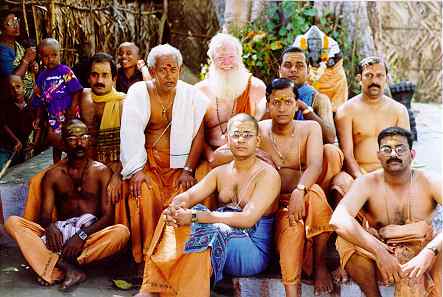
Carl Vadivella Belle, Ph.D. is a former diplomat whose career in the Australian Foreign Service was terminated on account of his devotional activities in Malaysia and Australia.. He is the author of Towards Truth: An Australian Spiritual Journey (Sydney: Pacific Press, 1992) and a practicing journalist and farmer outside Adelaide, Australia. He is also the editor of Bhakti! newsletter published in Canberra, Australia. He may be contacted at: 48 Adey Road
See also: |
